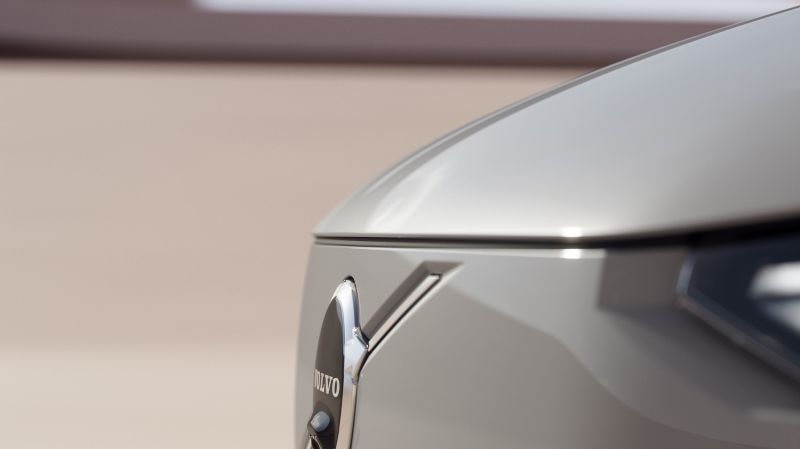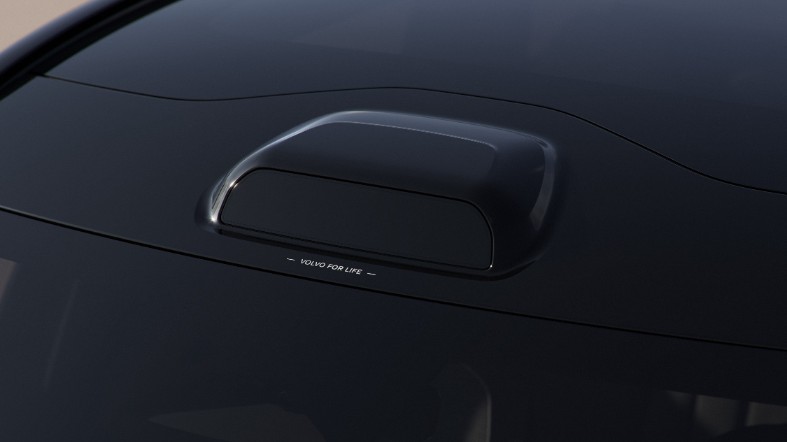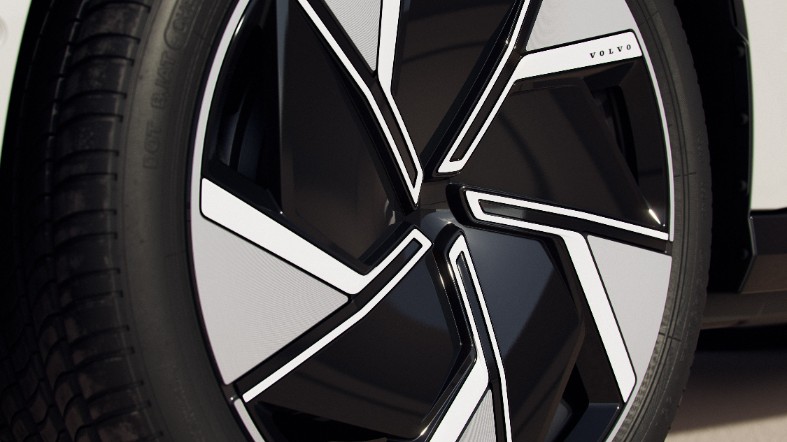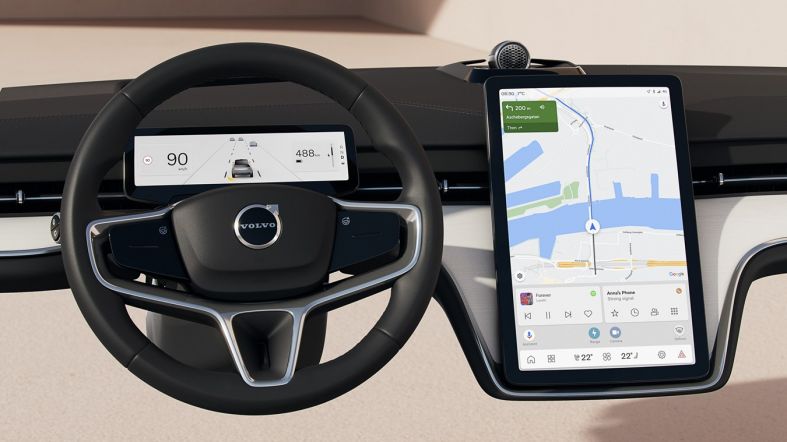Volvo Offers a Sneak Peak of its New Flagship EX90 Electric SUV Ahead of its Upcoming Reveal on Nov 9
【Summary】Automaker Volvo is set to officially unveil its new flagship EX90 electric SUV on November 9 in Stockholm, which is poised to compete with other luxury electric SUVs hitting the market from BMW, General Motors, Audi and Mercedes-Benz. Ahead of its upcoming debut next week, Volvo shared the first exterior photos of the battery-powered SUV.

Automaker Volvo is set to officially unveil its new flagship EX90 electric SUV on November 9 in Stockholm, which is poised to compete with other luxury battery-powered SUVs hitting the market from BMW, General Motors, Audi and Mercedes-Benz. Ahead of its upcoming debut next week, the automaker shared the first exterior photos on Tuesday.
The full-size EX90 is based on Volvo's XC90, which is currently the automaker's flagship gas powered SUV. The new electric SUV is designed to be an efficient electric family car, with a higher standard of safety than any other Volvo car before it, according to the automaker.
Among the safety highlights of the EX90 is its integrated roof-mounted lidar unit to support the EX90's advanced driver assist system (ADAS). The lidar sensor is supplied by Volvo's technology partner Luminar and delivers a higher level of vision & perception capabilities compared with camera and radar based systems.

The lidar unit is mounted discreetly in the roof of the EX90.
The integrated lidar will be an important piece of vehicle hardware as Volvo develops more advanced autonomous driving capabilities that can be updated via over-the-air software. The EX90 will be "hardware-ready" to support higher levels of automated driving.
The Luminar's lidar unit can detect a pedestrian from 250 meters away, according to Volvo. Integrating it into the roof of the EX90 instead of the front grill further improves its object detecting performance.
"It was a design challenge to integrate lidar in a way that both looks good and is optimal for its safety applications," said T. Jon Mayer, Volvo's Head of Exterior Design. "It's the car's eyes, and while you could have them around the grille area – which would be equivalent to having eyes on your knees – it makes much more sense to have them as high as possible on your head so you can see as much as possible."
In addition to the lidar sensor suite, the EX90 will also come with back-up systems for critical functions, such as steering and braking to support higher levels of autonomous driving once its made available.
Another design element that sets its apart from Volvo's XC90 gas-powered SUV is its more aerodynamic design. Volvo's engineers reshaped the EX90's exterior to increase its efficiency and reduce wind resistance. The EX90 also features flush-mounted door handles and aerodynamic alloy wheels to further reduce drag.

The EX90's aerodynamic wheels reduce drag to help improve range.
Other exterior improvements include a more rounded front end. As a result, the Volvo EX90 achieves a drag coefficient of 0.29, which is impressive for a full-size, 7-seater SUV.
The aerodynamic drag coefficient is a measure of how well a vehicle reduces air resistance. For a luxury electric vehicle like the EX90 with a near silent powertrain, a lower number translates into a quieter cabin with less wind noise at highway speeds.
"We've taken inspiration from yacht design to outline the Volvo EX90's beautiful and sleek proportions," says Mayer. "If you look at the front, it's proud and confident – inspired by a sailboat's ability to shear through the ocean's slamming waves. But it's also rounder overall, which enables the air to flow around the car more efficiently."
Volvo also offers a panoramic glass roof that makes the cabin brighter and appear more spacious. The panoramic roof lets as much light in as possible.

The EX90 features a large center-mounted touchscreen display and companion screen on the dash.
Another unique feature of the EX90 is an internal radar system that's accurate and sensitive enough to detect the tiniest movements and breathing of a sleeping toddler. It's designed to help address the terrible tragedy of accidentally leaving children or pets behind in a hot vehicle in the summer.
When a driver attempts to lock the EX90, the interior radar system is automatically activated and determines whether the cabin is empty of any people or pets, before it allows the SUV to be locked. This system will roll out to other Volvo models in the future, where regulations allow.
The fully-electric Volvo EX90 will join the XC40 and C40 Recharge in Volvo's lineup, along with the Polestar 2 from Volvo's electric brand Polestar.
In 2021, Volvo announced plans to transition to building only fully-electric vehicles by 2030. The company will electrify its entire model lineup, replacing all of its internal combustion engine models with pure electric vehicles by then.
In the interim, Volvo aims for hybrid models to make up 50% of its offering by 2025, but eventually the automaker's hybrid models will be replaced by fully-electric vehicles by 2030.
Volvo's transition towards becoming a fully-electric car company is part of its ambitious plan to address climate change, but it's also a way for the company to adapt to a changing auto industry that's quickly moving towards electrification.
-


Ford is Testing a New Robotic Charging Station to Assist Drivers of EVs With Disabilities
-


Ford Raises the Prices of the F-150 Lightning Electric Pickup Due to Rising Raw Material Costs
-


The BMW 7-Series to Feature HD Live Maps From HERE Technologies for Hands-Free Highway Driving in North America at Speeds up to 80 MPH
-


AutoX to Use the 'Eyeonic Vision Sensor' from California-based SiLC Technologies for its Robotaxi Fleet in China
-


LG Develops ‘Invisible’ Speaker Sound Technology That Could Revolutionize In-Vehicle Audio
-


Researchers at South Korea’s Chung-Ang University Develop a ‘Meta-Reinforcement’ Machine Learning Algorithm for Traffic Lights to Improve Vehicle Throughput
-


Zeekr’s New 009 Electric Passenger Van is the World’s First EV to Feature CATL’s Advanced ‘Qilin’ Battery With a Range of 510 Miles
-


Redwood Materials is Building an Electric Vehicle Battery Recycling Facility in South Carolina
- Ford Motor Co Selects its Plant in Spain to Build 'Breakthrough' EVs for the European Market on a Next-Gen Architecture
- Siemens Invests $25 Million in Wireless Charging Company WiTricity to Develop Interoperable Standards for Cable-free EV Charging
- Ford CFO Claims Inflation Has Erased Mustang Mach-E Profits
- Hyundai and Michelin to Develop Next-Gen Tires for EVs
- NHTSA Opens Investigations Into Two New Fatal Tesla Accidents
- Toyota Unveils the 2023 Crown, a Lifted Hybrid Sedan With 340 HP
- BorgWarner Invests $500 Million in Wolfspeed Inc, a Developer of Semiconductors and Silicon Carbide Devices for Electric Vehicles
- California DMV Accuses Tesla of Making False Claims About its Driver-Assist Systems
- The World’s Biggest Battery Producer CATL Signs MoU with EV Startup VinFast to Develop a ‘Skateboard’ Electric Vehicle Platform
- China’s New Intelligent EV company JIDU Launches its Limited-Edition Robocar Called the ‘ROBO-01 Lunar Edition’











 About Us
About Us Contact Us
Contact Us Careers
Careers